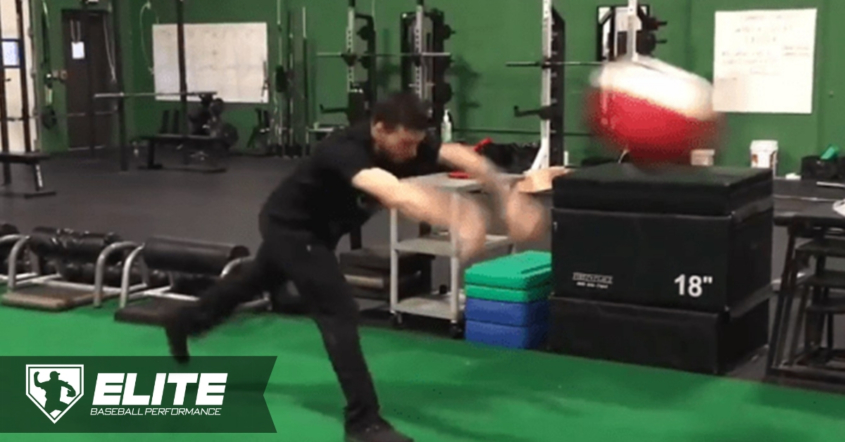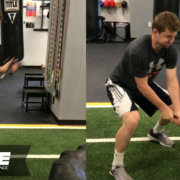How to Program Medicine Balls Into Baseball Workouts
Med ball exercises are a great way for a rotational athlete, such as a baseball player, to develop power and strength from their lower body to their upper body.
You often hear about rotational power or kinetic linking, but how do we maximize that? How does that relate to athletes, especially baseball and softball?
These qualities can be maximized with ballistic training. Movements often found in sports are considered ballistic.
What is ballistic movement?
“Movements that are performed with maximal velocity and acceleration can be considered ballistic actions. Ballistic actions are characterized by high firing rates, brief contraction times, and high rates of force development.” -Department of Kinesiology, McMaster University, Hamilton, Ontario.
SO, WHAT ARE SOME OF THE BENEFITS OF MED BALLS?
Here are just a few of the many benefits of training with med balls:
- Improved coordination in movements demanding high rate of force development in all planes of motion (especially rotational power)
- Improved ability to control and decelerate rotational forces
- Improved kinetic linking through which helps the ability to generate and transfer force through the body.
- Injury prevention because athletes are training to control rotation and deceleration.
After seeing some of those benefits, you can see why med balls are commonly seen in sports performance programs.
SETS & REPS
When done right, med balls can be a very demanding on the body and the central nervous system. We program all med ball work to be done BEFORE any lifting for that day.
We will pick 2-3 med ball drills per workout day that will benefit the athlete the most.
Taking that into consideration, here is a how we commonly program med balls for our athletes:
- 2 Days a Week Strength Program: 3-4 sets of 5-8 reps
- 3 Days a Week Strength Program: 3 sets of 5-8 reps
- 4 Days a Week Strength Program: 2-3 sets of 5-8 reps
TOP 5 CONSIDERATIONS FOR MED BALLS
STANCE
There are several positions you can begin your med ball exercises in. Typically, I work from the ground up with new athletes. This gives less room for error with form, and a progression to reach in the short and long term goals.
- Tall Kneeling (TK)
- 1/2 Kneeling
- Iso-Hold Stance
- Split Stance
- Athletic Stance
- Single Leg
Here are some examples:
TK Rotation Med Ball Slams
Iso Lunge Med Ball Side Scoops
Split Stance Med Ball Side Scoops
Athletic Stance Med Ball Chest Press
1 Leg Med Ball Side Scoops
DIRECTION & BALL PATH
Where is the athlete and med balls intended path? Taking the stances from above, now add in the follow 3 items:
- What direction is the athlete facing? Are they facing the wall, or facing sideways, etc.
- Where is the ball starting from? Is the ball starting above their head, at their side, at their hips, etc.
- Where is the ball going? What is the intended target or direction you want to slam/throw the ball?
INITIATION
There are typically 3 initiation methods for med ball exercises:
- Non-Counter Movement: This will be your traditional slam method. Accelerate at the wall, floor or target from a specific starting point.
- Counter Movement: This will be a movement initiated by a partner or a coil motion. The ball is moving against you so that you must stop, load, and then unload in your intended direction.
- Continuous: This will be a rapid movement – quick and precise. You will commonly see a plyo based or rubber bouncy ball for continuous med ball exercises.
MED BALL TYPES
There are several types of med balls out there. Some have handles, some are large, and some are small. Here are the common types we use with our athletes:
- Jam Balls: These balls won’t have much bounce. They are very dense, and can be on the heavier side.
- Plyo Balls: These are commonly smaller, and offer a bouncing recoil when you slam them. These are great for continuous and rapid med ball type exercises, and even single leg stance exercises.
- Soft Toss Med Ball: Commonly seen in gyms as Dynamax or PB Extreme Balls, these are great for slamming, tossing, and offer many uses.
INTENT
This may be the most important one. For athletes, one common goal is becoming faster and quicker. Med balls are great for developing these qualities. However, many athletes can’t check their ego at the door when they start training with med balls. They will grab the heaviest possible ball to throw or slam…VERY SLOWLY!
If the med ball is moving slowly, are you truly gaining the benefits of ballistic training? Probably not.
You have to put full effort and intent into each throw, and you have to find an appropriate weight that allows you to move quickly. This is how med balls were designed to be used. Med ball exercises are truly a “you get what you put into it” exercise.
Nick Esposito
Latest posts by Nick Esposito (see all)
- 5 Sprint Drills Designed for Baseball Players - October 8, 2019
- Nutrition for Baseball Performance - September 10, 2019
- The 3 Foundations to Your Nutrition: Macronutrients - August 13, 2019









What range balls (lbs) do you recommend for HS baseball players
For high schoolers, we range from 2-8 pounds. Our main focus is moving the ball fast, especially for throws at a wall such as scoop tosses, shotputs or 2 hand overhead throws. For slams to the ground, we can range from 4-10 depending on the athlete.
What size med ball do you recommend for a 9 year old pitcher to do these exercises with?
Hey Whitney, I would recommend a 2-4 lb med ball for many or most of these. I would also recommend to get one of the smaller med balls due to the size of some of the soft toss med balls. I know perform better is where we get ours from.
Hi, what size do you recommend for 12 & 16 years old? They both play baseball.
I would recommend a 4-6 pound ball for overhead throws to the wall.
For slams to the ground, 6-10 pound is a good range.
For scoops and shotput, I tend to be in 4-6 pound range consistently, with more advanced (pro athletes, advanced college) heading to the 8lb.
Hope that helps!
Nick
Thank you Nick for your response. I really appreciate it.